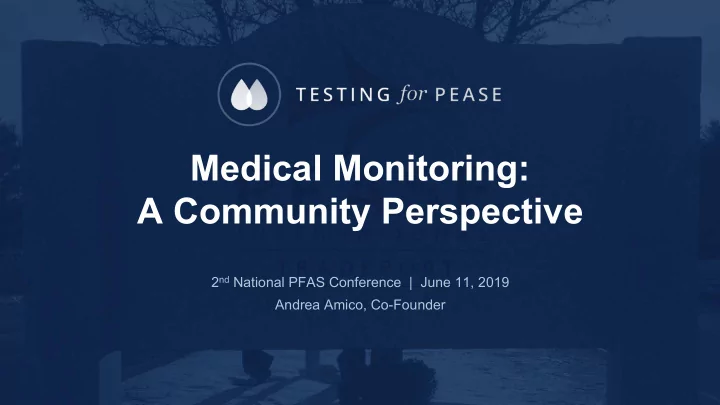

Medical Monitoring: A Community Perspective 2 nd National PFAS Conference | June 11, 2019 Andrea Amico, Co-Founder
Who is Testing for Pease? Testing for Pease is a community action group, whose mission is to be a reliable resource for education and communication while advocating for a long-term health plan on behalf of those impacted by the PFAS water contamination at the former Pease Air Force Base in Portsmouth, NH From left to right: Alayna, Andrea & Michelle 2
Why Did We Form? May 2014 newspaper article revealed that PFAS • contamination was discovered in three wells supplying drinking water to the Pease International Tradeport (former Pease Air Force Base) One municipal well (Haven well) tested over the EPA PHAs • that were in place at that time and closed down in May 2014 (remains closed today) Source of PFAS is AFFF use by the US Air Force • All of our children were exposed to contaminated public • drinking water at Pease 3
History Pease PFAS Blood Test Results 2015-2016 • Blood testing program for the Pease community started in 2015 and ended in 2018 • ATSDR formed Pease CAP in 2016 • ATSDR completed feasibility assessment in 2017 • Pease health study to *hopefully* start August 2019 https://www.dhhs.nh.gov/dphs/documents/pease-pfc-blood-testing.pdf
Health study is NOT medical monitoring • Health study will take years for data to be collected and analyzed • Health study only looks at certain endpoints (once) and is different than ongoing medical monitoring • Not all communities are participating in health studies • Medical monitoring can be done now to assess current health status and monitor for adverse health effects from PFAS exposure
What is medical monitoring? • ATSDR : defined in the legislation as “the periodic medical testing to screen people at significant increased risk for disease.” • Medical dictionary : performance of medical tests and physical exams to evaluate an individual’s ongoing exposure to a factor that could negatively impact on that person’s health. What is biomonitoring? • CDC : Involves measuring environmental chemicals, or their breakdown products (metabolites), in human tissues and fluids, such as blood and urine. https://www.govinfo.gov/content/pkg/FR-1995-07-28/html/95-18578.htm https://www.cdc.gov/biomonitoring/about.html https://medical-dictionary.thefreedictionary.com/medical+monitoring
Why do we need medical monitoring? • Community PFAS blood tests are elevated when compared to national average (NHANES) • PFAS are associated with multiple adverse health effects that impact multiple systems of the human body • affect growth, learning, and behavior of infants and older children • lower a woman’s chance of getting pregnant • interfere with the body’s natural hormones • increase cholesterol levels • affect the immune system • increase the risk of cancer https://www.atsdr.cdc.gov/pfas/health-effects.html
Why do we need medical monitoring? • PFAS bioaccumulate and have long half lives • Many children exposed at very young ages/ critical windows of development – how will this impact their health over time? • Community wants to know if they are at risk for health effects • Community wants to know how to prevent disease as a result of their exposure to PFAS and/or diagnose health issues early to prevent progression of disease and negative impacts to health
Challenges • Local healthcare providers are unaware of PFAS in general and associated health effects – community reports mixed response from providers • Physicians are unaware of how to interpret PFAS blood test results for their patients (and also how to order PFAS blood tests)
Challenges • Physicians in general receive minimal training in environmental health • Association of American Medical Colleges article: • 1 in 5 pediatricians received training in environmental history taking. • medical students received just seven hours of environmental content training. • nearly one-quarter of schools surveyed did not require any environmental content. • AAMC’s 2013 survey of medical school graduates found that more than one-third of respondents said they received “inadequate” instruction in environmental health.” https://news.aamc.org/medical-education/article/experts-importance-environmental-health-content/
C8 Science Panel Findings • 3 epidemiologists carried out exposure and health studies in the Mid-Ohio Valley communities in 2005-2013 • Probable link between exposure to C-8 (PFOA) and the following human diseases: • pregnancy-induced hypertension (including preeclampsia), • kidney cancer • testicular cancer • thyroid disease • ulcerative colitis • high cholesterol (hypercholesterolemia) http://www.c8sciencepanel.org/ http://www.c8medicalmonitoringprogram.com/docs/registration_form.pdf
C8 Medical Monitoring Program http://www.c-8medicalmonitoringprogram.com/docs/med_panel_education_doc.pdf
Community medical monitoring needs • Better outreach and physician education on PFAS and potential health effects – needs to be a multipronged approach • Short term: • Establish informal medical monitoring guidelines for physicians and patients to review to make informed and joint decisions on the need for additional medical testing • Long term: • Fund and establish a formal medical monitoring program that will allow for sharing of data and minimize costs to impacted community members • Make access to PFAS blood tests less expensive and easier to obtain
Summary • Medical monitoring is periodic medical testing and physical exams to screen people at significant increased risk for disease • Impacted community members worry about the impacts of PFAS exposure on their health (short and long term) • Physicians need better education and outreach (especially in PFAS exposed communities) in a multipronged approach • Medical monitoring is a very basic tool that can be given to exposed communities in the absence of blood tests and health studies • The lack of medical monitoring is an area of PFAS exposure that is not being addressed as it should be – please help!
Thank you “Never doubt that a small group of thoughtful, committed citizens can change the world; indeed, it’s the only thing that ever has.” ~ Margaret Mead For more information, please visit: www.testingforpease.com facebook.com/TestingforPease 15
Recommend
More recommend